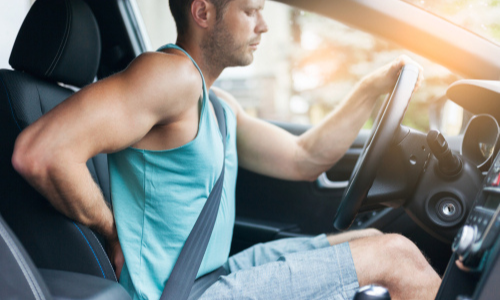
How to Prevent Pain While Traveling
Do you suffer from neck or back pain for days after a long car, plane, bus, or train trip? Sitting for hours stresses your spine, joints, ligaments, discs, and muscles, causing those travel-related aches and pains.
How Traveling Causes Pain
After you remain in the same position for a few hours, your joints and muscles tend to tighten. When this happens, your range of motion may decrease. As a result, the slightest movement can lead to painful muscle spasms or even strained muscles. Reaching forward to change the radio station or turning your head to look out the window can trigger jolts of pain if your muscles and joints are too tight.
Long trips can aggravate existing back or neck conditions, including arthritis, herniated discs, spinal stenosis, degenerative disc disease, and sciatica.
Sitting affects your spine's ability to support your body adequately. When you sit, the natural curve in your lower back flattens, while pressure on your spinal discs increases, according to a study published in the Asian Spine Journal.
Seat design is another issue. Although seat designers try to accommodate a range of body types and sizes, it's difficult to construct a seat that fits everyone equally well. If the headrest is too tall to fit your neck, or the seat doesn't offer enough lower back support, you're more likely to experience some degree of pain if your trip lasts more than an hour or two.
What You Can Do to Prevent Pain
Fortunately, pain can be avoided, or at least decreased, by following a few of these suggestions:
- Take Regular Breaks: Break long car trips into two- or three-hour-long segments. If you're a passenger in a plane or train, get up and walk up and down the aisle a few times after two or three hours. Walking not only keeps your muscles and joints limber but also reduces the risk of blood clots on long trips.
- Try a Few Stretches: Stretching before, during, and after long trips will help keep your joints and muscles limber, reduce spasms, and prevent range of motion restrictions.
- Be Prepared: Pack a few things that make your trip more comfortable. If long trips leave you with an aching neck and a headache, use a headrest pillow or a U-shaped neck pillow. When back pain is an issue, buy a cushion that helps support the curves of your lower back. Bring a pillow or cushion to sit on if you often develop shooting pain in your back and legs after sitting for a few hours.
- Use Pain-Relieving Patches, Ointments, or Tape: Pain-relieving capsicum patches or ointments can help ease muscle pain, while kinesiology tape applied to your neck or shoulders can reduce stress, pain, and swelling. If cold is most helpful, bring a few cold packs to ease your pain. (If you're traveling by air, you may not be able to bring the packs.)
- Improve the Way You Sit: Slouching increases pressure on your back and neck and can increase aches and pains. Remind yourself to maintain good posture while sitting. Keeping your seat upright will make it more difficult to slouch. If sciatica or tailbone pain is a problem for you, put most of your weight on the bones in your legs, rather than your tailbone, when you sit.
- See Your Chiropractor: Visiting your chiropractor before and after long trips can help you avoid pain. During your pre-trip visit, your chiropractor will offer treatments to improve the alignment of your spine and reduce muscle tension. If these issues aren't corrected, you'll be much more likely to experience pain. Treatments after your trip will focus on restoring spinal alignment, eliminating spasms and muscle pain, reducing inflammation, and improving range of motion.
Do you have a long trip planned soon? Chiropractic care can enhance your comfort. Contact our office to schedule your pre- or post-trip visit.
Sources:
Edmunds: Creating the Perfect Fit: New Car Seat Design
Spine Health: 7 Tips to Alleviate Back Pain on Your Road Trips, 9/12/19
